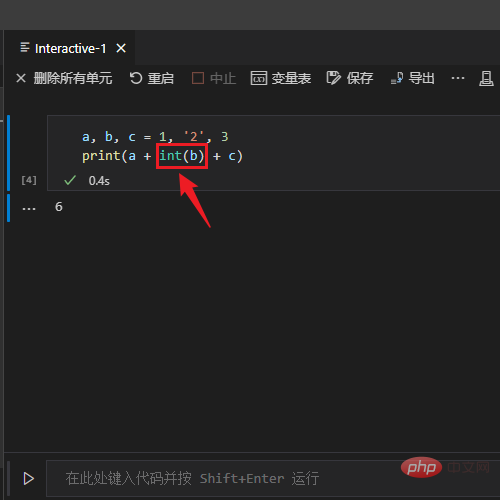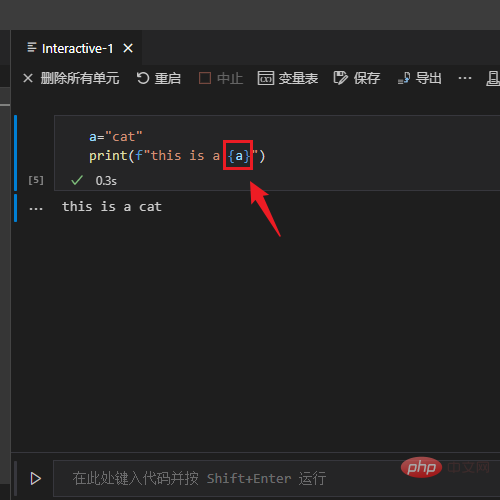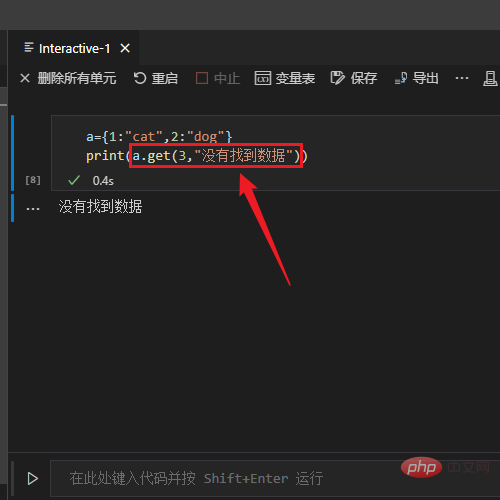Variables and data types in Python
Python is a language with weak data types. Variables can be used without declaration. Assigning a value to a variable means defining the variable. The type of the value assigned is the type of the variable, but the variable also has a data type, string '1 'If you want to participate in data calculation, you need to use the int() function for conversion, and use the type() function to view the data type of the variable.

Variables store references to the memory addresses of data. Variables in Python are divided into unmodifiable variables and modifiable variables. Unmodifiable variables include int, float, and str strings. , tuple tuples, etc. Modifiable variables include list list, dict dictionary, set collection, etc. When passing parameters to a function, python always passes a reference to the value. However, if the value passed is an unmodifiable variable, a copy will be passed to the function because it cannot be modified. How can the value passed be a modifiable list or dictionary? etc., then the references to these values are passed directly and can be modified within the function body.
Data types in python:
String: A sequence of characters enclosed in single or double quotes. To use variables in a string, you can use f string. This is a newly introduced function in python3.7. It is very convenient to use. Add f before the first quotation mark of the string, and you can use { in the string. } Curly braces insert variables into the string, such as f"thisis a {cat}", where cat is a variable name.

Numeric type: Integer int, dot number float, numerical type can be added, subtracted -, multiplied *, divided /, exponentiated** , take the remainder % and other operations.
List: A collection of ordered and modifiable data enclosed in square brackets [] and separated by commas. For example, [1,2,3,4,5], add elements in the list using the appand() method, insert elements using the insert() method, and delete elements using the del statement, pop() method or remove() method. The sort() method is used to sort the list, the sorted() method is used for temporary sorting, the reverse() method is used for reverse order, the len() method is used to obtain the length of the list, and the for...in... statement is used to traverse the list.
Tuple: A list is a modifiable data collection, while a tuple is an immutable list, a set of data collections enclosed in parentheses () and separated by commas.
Dictionary: The dictionary is a data collection of a series of key-value pairs, enclosed in curly braces {}, and separated by commas. The key-value pairs are separated by colons: , each key is associated with its value, which can be any data type, even a list or dictionary itself. Some operations on dictionaries are very similar to lists. You can use the get() method to obtain a key-value pair that may not exist.

The above is the detailed content of Variables and data types in Python. For more information, please follow other related articles on the PHP Chinese website!

Hot AI Tools

Undresser.AI Undress
AI-powered app for creating realistic nude photos

AI Clothes Remover
Online AI tool for removing clothes from photos.

Undress AI Tool
Undress images for free

Clothoff.io
AI clothes remover

Video Face Swap
Swap faces in any video effortlessly with our completely free AI face swap tool!

Hot Article

Hot Tools

Notepad++7.3.1
Easy-to-use and free code editor

SublimeText3 Chinese version
Chinese version, very easy to use

Zend Studio 13.0.1
Powerful PHP integrated development environment

Dreamweaver CS6
Visual web development tools

SublimeText3 Mac version
God-level code editing software (SublimeText3)

Hot Topics
 1666
1666
 14
14
 1425
1425
 52
52
 1328
1328
 25
25
 1273
1273
 29
29
 1253
1253
 24
24
 PHP and Python: Different Paradigms Explained
Apr 18, 2025 am 12:26 AM
PHP and Python: Different Paradigms Explained
Apr 18, 2025 am 12:26 AM
PHP is mainly procedural programming, but also supports object-oriented programming (OOP); Python supports a variety of paradigms, including OOP, functional and procedural programming. PHP is suitable for web development, and Python is suitable for a variety of applications such as data analysis and machine learning.
 Choosing Between PHP and Python: A Guide
Apr 18, 2025 am 12:24 AM
Choosing Between PHP and Python: A Guide
Apr 18, 2025 am 12:24 AM
PHP is suitable for web development and rapid prototyping, and Python is suitable for data science and machine learning. 1.PHP is used for dynamic web development, with simple syntax and suitable for rapid development. 2. Python has concise syntax, is suitable for multiple fields, and has a strong library ecosystem.
 How to run sublime code python
Apr 16, 2025 am 08:48 AM
How to run sublime code python
Apr 16, 2025 am 08:48 AM
To run Python code in Sublime Text, you need to install the Python plug-in first, then create a .py file and write the code, and finally press Ctrl B to run the code, and the output will be displayed in the console.
 PHP and Python: A Deep Dive into Their History
Apr 18, 2025 am 12:25 AM
PHP and Python: A Deep Dive into Their History
Apr 18, 2025 am 12:25 AM
PHP originated in 1994 and was developed by RasmusLerdorf. It was originally used to track website visitors and gradually evolved into a server-side scripting language and was widely used in web development. Python was developed by Guidovan Rossum in the late 1980s and was first released in 1991. It emphasizes code readability and simplicity, and is suitable for scientific computing, data analysis and other fields.
 Why Use PHP? Advantages and Benefits Explained
Apr 16, 2025 am 12:16 AM
Why Use PHP? Advantages and Benefits Explained
Apr 16, 2025 am 12:16 AM
The core benefits of PHP include ease of learning, strong web development support, rich libraries and frameworks, high performance and scalability, cross-platform compatibility, and cost-effectiveness. 1) Easy to learn and use, suitable for beginners; 2) Good integration with web servers and supports multiple databases; 3) Have powerful frameworks such as Laravel; 4) High performance can be achieved through optimization; 5) Support multiple operating systems; 6) Open source to reduce development costs.
 Python vs. JavaScript: The Learning Curve and Ease of Use
Apr 16, 2025 am 12:12 AM
Python vs. JavaScript: The Learning Curve and Ease of Use
Apr 16, 2025 am 12:12 AM
Python is more suitable for beginners, with a smooth learning curve and concise syntax; JavaScript is suitable for front-end development, with a steep learning curve and flexible syntax. 1. Python syntax is intuitive and suitable for data science and back-end development. 2. JavaScript is flexible and widely used in front-end and server-side programming.
 MySQL vs. Other Programming Languages: A Comparison
Apr 19, 2025 am 12:22 AM
MySQL vs. Other Programming Languages: A Comparison
Apr 19, 2025 am 12:22 AM
Compared with other programming languages, MySQL is mainly used to store and manage data, while other languages such as Python, Java, and C are used for logical processing and application development. MySQL is known for its high performance, scalability and cross-platform support, suitable for data management needs, while other languages have advantages in their respective fields such as data analytics, enterprise applications, and system programming.
 Golang vs. Python: Performance and Scalability
Apr 19, 2025 am 12:18 AM
Golang vs. Python: Performance and Scalability
Apr 19, 2025 am 12:18 AM
Golang is better than Python in terms of performance and scalability. 1) Golang's compilation-type characteristics and efficient concurrency model make it perform well in high concurrency scenarios. 2) Python, as an interpreted language, executes slowly, but can optimize performance through tools such as Cython.




